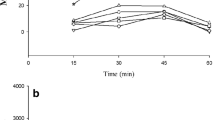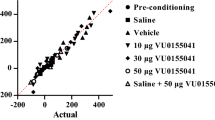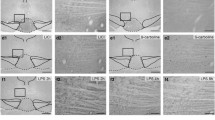Abstract
Several lines of evidence have shown that aversive states are under the influence of opioid mechanisms in the dorsal periaqueductal gray (DPAG). In order to characterize the type of opioid receptors involved in these effects in this work we injected DAMGO and U50,488H,μ andκ selective agonists, respectively, directly in this structure. Rats implanted with chemitrode in the DPAG were submitted to the elevated plus maze test for 5 min. The effects of DAMGO (0.1–1 nmol/0.2μl) and U50,488H (1–10 nmol/0.2 µl) following administration into DPAG were studied. Low doses of DAMGO (0.1 and 0.3 nmol) caused dose-dependent increases in the number of entries and time spent in the open arms while an overall deficit in the exploratory activity was produced by the higher dose used (1.0 nmol). Clear aversive effects were observed following the administration of U50,488H in the DPAG. The antiaversive effects of 0.3 nmol DAMGO were inhibited by the intraperitoneal administration of theμ receptor antagonist naltrexone (2.0 mg/kg, IP) whereas the aversive effects of 5.0 nmol U50,488H were antagonized by the selectiveκ receptor antagonist nor-binaltorphimine (1.0 mg/kg, IP). It is suggested that activation ofμ receptors inhibit and κ receptors enhance the neural substrate of aversion in the DPAG.
Similar content being viewed by others
References
Bals-Kubik R, Herz A, Shippenberg TS (1989) Evidence that the aversive effects of opioid antagonists andκ-agonists are centrally mediated. Psychopharmacology 98:203–206
Bandler R, Carrive P (1988) Integrated defence reaction elicited by excitatory amino acid microinjection in the midbrain periaqueductal grey region of the unrestrained cat. Brain Res 439:95–106
Bechara A, Van der kooy D (1987) Opposite motivational effects of endogenous opioids in brain and periphery. Nature 314:533–534
Brandão ML, Aguiar JC, Graeff FG (1982) GABA mediation of the antiaversive action of the minor tranquilizers. Pharmacol Biochem Behav 16:397–402
Brandão ML, Cabral AM, Vasquez EC, Schmitt P (1985) Chlordiazepoxide and morphine reduce pressor response to brain stimulation in awake rats. Pharmacol Biochem Behav 23:1069–1071
Brandão ML, DiScala G, Bouchet MJ, Schmitt P (1986) Escape behavior produced by the blockade of glutamic acid decarboxylase (GAD) in mesencephalic central gray or medial hypothalamus. Pharmacol Biochem Behav 24:497–501
Brandão ML, Coimbra NC, Leao Borges PC (1990) Effects of morphine and midazolam on reactivity to peripheral noxious and central aversive stimuli. Neurosci Biobehav Rev 14 (4):495–499
Brandão ML, Melo LL, Cardoso SH (1993) Mechanisms of defense in the inferior colliculus. Behav Brain Res 58:49–57
Brandão ML, Cardoso SH, Melo LL, Coimbra NC, Motta V (1994) Neural substrate of defensive behavior in the midbrain tectum. Neurosci Biobehav Rev 18:339–346
Goldstein A (1987) Binding selectivity profiles for ligands of multiple receptor types: focus on opioid receptors. Trends Pharmacol Sci 8:456–459
Graeff FG (1990) Brain defense systems and anxiety. In: Roth M, Burrow GD, Noyes R (eds) Handbook of anxiety, vol. 3 Elsevier Science Publishers, Amsterdam, pp 307–354
Hunsperger RW (1956) Affektreaktionen auf electrische Reizung im Hirnstamm der Katze. Helv Physiol Pharmacol Acta 14:70–92
Jacquet YF, Squires RF (1988) Excitatory amino acids: role in morphine excitation in rat periaqueductal gray. Behav Brain Res 31:85–88
Jacquet YF, Saedrup E, Squires RF (1987) Non-stereospecific excitatory actions of morphine may be due to GABAAreceptor blockade. Eur J Pharmacol 138:285–288
Jenck F, Schmitt P, Karli P (1983) Morphine applied to the mesensephalic central gray suppresses brain stimulation escape. Pharmacol Biochem Behav 19:301–308
Jenck F, Schmitt P, Karli P (1986) Morphine injected into the periaqueductal gray attenuates brain stimulation- induced effects: an intensity discrimination study. Brain Res 378:274–284
Mansour A, Khachaturian H, Lewis ME, Akil H, Watson SJ (1988) Anatomy of CNS opioid receptors. Trends Neurosci 11:308–314
Marseillan RF (1977) A solid styate sine wave stimulator. Physiol Behav 19:339–340
Martin WR (1983) Pharmacology of opioids. Pharmacol Rev 35:283–323
Motta V, Brandão ML (1993) Aversive and antiaversive effects of morphine in the periaqueductal gray of rats submitted to the elevated plus-maze test. Pharmacol Biochem Behav 44:119–125
Mucha RF, Herz A (1985) Motivational properties of kappa and mu opioid receptor agonists studied with place and taste preference conditioning. Psychopharmacology 86:274–280
Olds ME, Olds J (1963) Approach avoidance analysis of rat diencephalon. J Comp Neurol 120:259–295
Paxinos G, Watson P (1986) The rat brain in stereotaxic coordinates. Academic Press, New York
Pellow S, File SE (1986) Anxiolytic and anxiogenic drug effects on exploratory activity in an elevated plus- maze: a novel test of anxiety in the rat. Pharmacol Biochem Behav 24:525–529
Pellow S, Chopin P, File SE, Briley M (1985) Validation of open: closed arm entries in the elevated plus-maze as a measure of anxiety in the rat. J Neurosci Meth 14:149–167
Portoghes PS, Lipkowski AW, Takemori AE (1987) Binaltorphimine and nor-binaltorphimine, potent and selectiveκ-opioid receptor antagonists. Life Sci 40:1287–1292
Readgrave P, Marrow L, Dean P (1992) Topographical organization of the nigrotectal projection in rat: evidence for segregated channels. Neuroscience 50:571–595
Robson LE, Pasterson SJ, Kosterlitz HW (1983) Opiate receptor. In: Iversen LL, Snyder SH(eds) Handbook of psychopharmacology, vol. 17. Plenum Press, New York, pp 13–80
Schmitt P, Carrive P, DiScala G, Jenck F, Brandão ML, Bagri A, Moreau JL, Sandner G (1986) A neuropharmacological study of the periventricular neural substrate involved in flight. Behav Brain Res 22:181–190
Shaikh MB, Lu CL, Siegel A (1991) affective defense behavior elicited from the feline midbrain periaqueductal gray is regulated by mu- and delta-opioid receptors. Brain Res 557:344–348
Tempel A, Gardner EL, Zukin RS (1985) Neurochemical and functional correlates of naltrexone-induced opiate receptor up-regulation. J Pharmacol Exp Ther 232:439–444
Von Voigtlander PF, Lahtie RA, Ludens JH (1983) U50,488: selective and structurally novel non-mu (kappa) opioid agonist. J Pharmacol Exp Ther 224:7–12
Woods JH, Winger G (1987) Opioids, receptors and abuse liability. In: Meltzer HY (ed) Psychopharmacology: the third generation of progress. Raven Press, New York, pp 1555–1564
Author information
Authors and Affiliations
Rights and permissions
About this article
Cite this article
Motta, V., Penha, K. & Brandão, M.L. Effects of microinjections of μ and κ receptor agonists into the dorsal periaqueductal gray of rats submitted to the plus maze test. Psychopharmacology 120, 470–474 (1995). https://doi.org/10.1007/BF02245820
Received:
Revised:
Issue Date:
DOI: https://doi.org/10.1007/BF02245820




